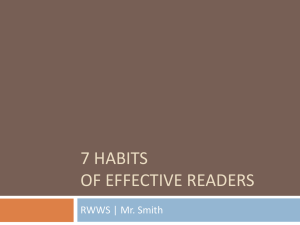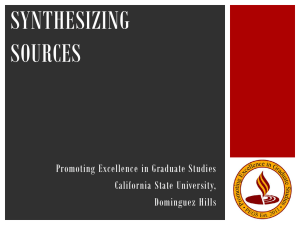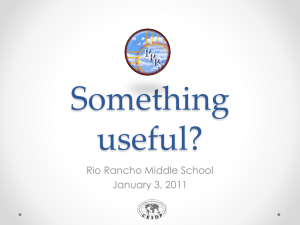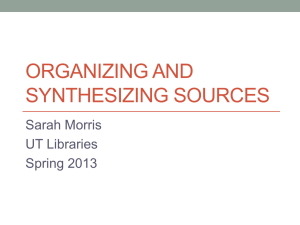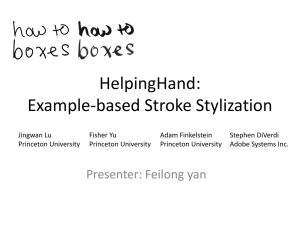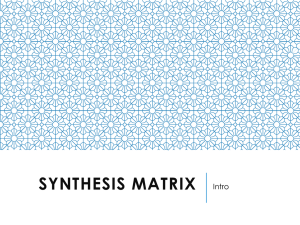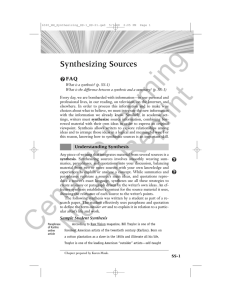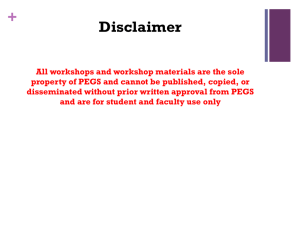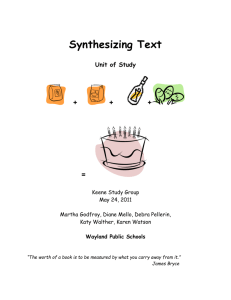Synthesizing to Build Reading Comprehension - Isles District 4
advertisement
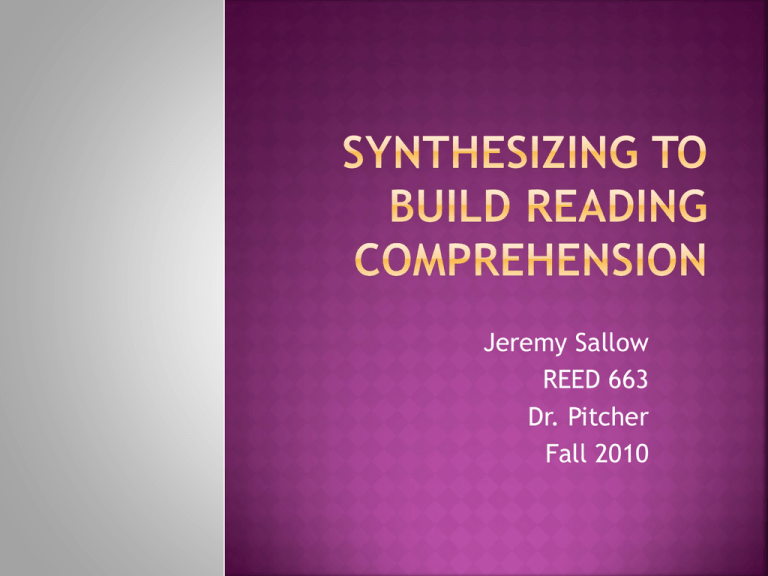
Jeremy Sallow REED 663 Dr. Pitcher Fall 2010 “Synthesizing is the process whereby a student merges new information with prior knowledge to form a new idea, perspective, or opinion to generate insight” (Bumgarner, 2010, p. 1). Synthesizing while reading allows students to form a deeper understanding of text. It also creates an increased ability to comprehend and form new ideas. When students are able to connect multiple texts or prior knowledge, a deeper meaning is gained. This study was completed with my fifth grade students at Timber Grove Elementary The lessons were completed over a 30 minute period for several days. The lessons applied the gradual release model as the lessons continued. Before beginning with synthesizing instruction, I began with a review of questioning and summarizing, two skills necessary to synthesize. This was a brief review of how to use questioning and how to generate a summary. These two skills were also modeled when creating a synthesis. I introduce the book The Other Side by Jacqueline Woodson. I informed the students that today we would be reading the story to generate a synthesis of The Other Side. I asked the students if they knew what synthesizing was and was not surprised that the students were not aware of synthesizing. I explained to my students that synthesizing would include how they felt about what they were going to read, which the students enjoyed. I informed the students that as we read we would generate a list of questions that we had from the story. This list of questions was generated by modeling my own thoughts while reading. Additional questions were generated by students as we continued to read. The questions were typed on a list for tomorrows lesson. Class Questions from The Other Side What does Clover’s mom mean when she says, “That’s the way it has always been?” Why don’t we know the girls’ names until later in the book? Why does Annie keep calling the little girl, “that girl”? What does the fence symbolize? What is the time period of this story? Why did mama say that it wasn’t safe to climb over the fence and play? Why did Sandra say no to the little girl when she asked to play with the girls? Why didn’t Mama say anything to Clover when she was sitting on the fence? Why do the girls say that one day someone is going to knock the fence down? I began the second lesson by re-reading The Other Side to the class. We then went over the questions we generated from the previous day. I asked students for some answers to our questions in order to form a better understanding of the text. Today’s focus in on summarizing the story in order to help students generate a synthesis. I showed the students a summary of the story that I had written the day before. The summary was displayed on a chart, but only the summary side was displayed. After discussing with the class the different points of the summary I showed them the my thoughts and ideas part of the chart. I displayed a model for synthesizing from the book The Other Side. The underlined portion highlights my thoughts and ideas about the story. In today’s lesson the students are given a selection from Don’t Know Much About Rosa Parks. The students were directed to read the selection with a partner and then generate a summary of the section together. As the students are working on the summary I walked around to check with each group to make sure the summaries were on point. After students completed the summary they began to focus on their own thoughts using the chart to write down their thoughts and ideas. After listing their thoughts and ideas the students began to write their synthesis of the summary and their ideas. As the students work I check with each table to make sure they are understanding the synthesizing strategy. This student is working on her synthesis of the guided practice. She completed the chart and is using the information to complete the written synthesis. The students were allowed to choose from a variety of books in order to complete their assessment activity for this lesson. The students began by using the chart to write the summary and their thoughts and ideas. After the students completed the chart they wrote their synthesis by combining their ideas. This is one of my students working on the graded assessment. He is using the chart to write his synthesis. This student chose the book about Tony Hawk’s life. The students did well during the teacher model. They were focus and engaged and offered many questions and ideas. The students did well during the guided practice, but did have some questions as to how to combine the summary and their thoughts. The students did well on the assessment. They were able to generate a synthesis that clearly showed a combination of the story details and their own thoughts and ideas. These lessons follow a skill that has become a primary focus over the last few years in Baltimore County. The education field has pushed for students to make personal connections with the text to build comprehension. I chose to share this lesson with two of my fellow teammates since synthesizing is taught primarily in fifth grade. I emailed the project to Ms. RouchardVollmer and Ms. Patricia Carroll and asked them to provide feedback on the lesson. Most of the curriculums we are given include low level thinking activities or questions as the students are expected to show comprehension of the skills and concepts. Unfortunately, this is not enough for our students. Synthesis is a necessary skill that involves higher level thinking, and our students must be taught how to think at a higher level just as we teach them how to comprehend. This lesson is a great combination of lower level and higher level thinking as students must summarize the text while incorporating their own opinions and prior knowledge. Through this lesson students will be able to see that they must be active readers who think about the text rather than innocent bystanders who just take in the information. We must do this type of lesson more often as we must show our students that we value their ideas, prior knowledge, and connections. -TRICIA 1.) Relating the text to how the students feel is great since we often ask them to regurgitate their reading rather than interacting and relating to it. Synthesizing allows for personal connections which often go deeper than just retelling a beginning, middle and end. 2.) I like how you chose a book in the teacher guided practice that was similar to the instruction piece since it was easy for the children to remember certain things from the previous worksheets on race differences. It also is a hidden curriculum piece in regards racism and tolerance, and since we have a diverse school population, the children can definitely make personal meaningful connections. 3.) Having the students choose their own book that interests them to create a synthesis is crucial to meaningful, personal connections. When the students get to choose, it not only empowers them as learners, but they can make those connections and relationships easily throughout text to self, text to world and even text to text (if their interests span a variety of those types of books). Jess Mrs. Rouchard-Vollmer J. Rouchard-Vollmer 5th Grade,Timber Grove Elementary http://teachers.bcps.org/teachers_elem/jrouchard/ From this lesson one thing that I learned from my students is that they had difficulty with summarizing and needed to focus on that skill before delving into synthesizing. I liked the lesson and thought that it went well, but it can be time consuming so make sure to limit the instruction to 30 minutes a day to leave time for other instruction. I did go over the 30 minutes a couple days and could have made this a five day lesson instead of four. This is a lesson that can be used from year to year. The general idea of the lesson can be adapted to a variety of texts. This lesson will work for a variety of age groups, but does need to be modified for primary students. This lesson can be used by many teachers and can be adapted for different level students. Bumgarner, Shannon. (2010). Advancing adolescent literacy instruction together. Synthesizing. Retrieved on October 10, 2010 from http://ohiorc.org/adlit/strategy/strategy_e ach.asp x?id=000002.
